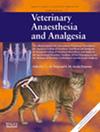Characterization of the anesthetic effects of dexmedetomidine–vatinoxan–ketamine combinations in cats
IF 1.9
2区 农林科学
Q2 VETERINARY SCIENCES
引用次数: 0
Abstract
Objective
To characterize the anesthetic effects of dexmedetomidine, vatinoxan and ketamine combinations in cats.
Study design
Randomized crossover experimental study.
Animals
A group of seven healthy male neutered cats, with body mass 5.2 ± 0.4 kg and aged 1–2 years.
Methods
Cats were implanted with a telemetric transmitter for remote recording of mean arterial pressure and heart rate before beginning the study. Each cat received a total of six treatments, coadministered in a single syringe, each at least 2 weeks apart: dexmedetomidine (25 μg kg–1, D) + vatinoxan (600 μg kg–1, V) + ketamine (2.5 mg kg–1, K2.5) intramuscularly (IM) (DVK2.5IM); D + V + ketamine (5 mg kg–1, K5) IM (DVK5IM); D + V + ketamine (10 mg kg–1, K10) IM (DVK10IM); D + K5 IM (DK5IM); D + V + K5 subcutaneously (SC) (DVK5SC); or D + V + K5 intravenously (IV) (DVK5IV). Select physiologic variables and time to recumbency, immobilization, first movement, head lift, return to sternal recumbency and walking were recorded. Quality of sedation/anesthesia was assessed using a visual analog score. Response to noxious electrical stimulation was assessed at 10 minute intervals.
Results
Heart rate (beats minute–1) was significantly greater in DVK5IM (overall mean ± standard deviation 142 ± 19) than in DK5IM (115 ± 16). No treatment consistently prevented movement in response to noxious stimulation. Time to first movement was significantly shorter in DVK2.5IM (45 ± 10 minutes) than in DVK10IM (93 ± 25 minutes), and in DVK5IM (53 ± 12 minutes) than in DK5IM (95 ± 39 minutes).
Conclusions and clinical relevance
Dexmedetomidine–vatinoxan–ketamine combinations, at the doses studied, may be useful to produce sedation, but do not appear to consistently produce anesthesia as characterized by immobility in response to noxious stimulation.
右美托咪定-瓦替诺克-氯胺酮联合用药对猫的麻醉效果。
目的:观察右美托咪定、瓦替诺珊和氯胺酮联合用药对猫的麻醉效果。研究设计:随机交叉实验研究。动物:7只健康雄性绝育猫,体重5.2±0.4 kg,年龄1-2岁。方法:在研究开始前,给猫植入一个遥测发射器,用于远程记录平均动脉压和心率。每只猫共接受6次治疗,每次注射间隔至少2周:右美托咪定(25 μg kg-1, D) +瓦替诺森(600 μg kg-1, V) +氯胺酮(2.5 mg kg-1, K2.5)肌注(DVK2.5IM);D + V +氯胺酮(5mg kg-1, K5) IM (DVK5IM);D + V +氯胺酮10mg kg-1, K10) IM (DVK10IM);D + k5im (dk5im);皮下D + V + K5 (DVK5SC);或静脉D + V + K5 (DVK5IV)。记录选择的生理变量和平卧、固定、首次运动、头举、恢复胸骨平卧和行走的时间。使用视觉模拟评分评估镇静/麻醉质量。每隔10分钟评估一次对有害电刺激的反应。结果:DVK5IM组的心率(心跳分钟-1次)(总平均值±标准差142±19)明显高于DK5IM组(115±16)。没有一种治疗方法能持续地阻止对有害刺激的反应。DVK2.5IM组第一次运动时间(45±10分钟)明显短于DVK10IM组(93±25分钟),DVK5IM组(53±12分钟)明显短于DK5IM组(95±39分钟)。结论和临床意义:在研究的剂量下,右美托咪定-瓦替诺克-氯胺酮组合可能有助于产生镇静,但似乎不能持续产生麻醉,其特征是对有害刺激的反应不动。
本文章由计算机程序翻译,如有差异,请以英文原文为准。
求助全文
约1分钟内获得全文
求助全文
来源期刊

Veterinary anaesthesia and analgesia
农林科学-兽医学
CiteScore
3.10
自引率
17.60%
发文量
91
审稿时长
97 days
期刊介绍:
Veterinary Anaesthesia and Analgesia is the official journal of the Association of Veterinary Anaesthetists, the American College of Veterinary Anesthesia and Analgesia and the European College of Veterinary Anaesthesia and Analgesia. Its purpose is the publication of original, peer reviewed articles covering all branches of anaesthesia and the relief of pain in animals. Articles concerned with the following subjects related to anaesthesia and analgesia are also welcome:
the basic sciences;
pathophysiology of disease as it relates to anaesthetic management
equipment
intensive care
chemical restraint of animals including laboratory animals, wildlife and exotic animals
welfare issues associated with pain and distress
education in veterinary anaesthesia and analgesia.
Review articles, special articles, and historical notes will also be published, along with editorials, case reports in the form of letters to the editor, and book reviews. There is also an active correspondence section.
 求助内容:
求助内容: 应助结果提醒方式:
应助结果提醒方式:


